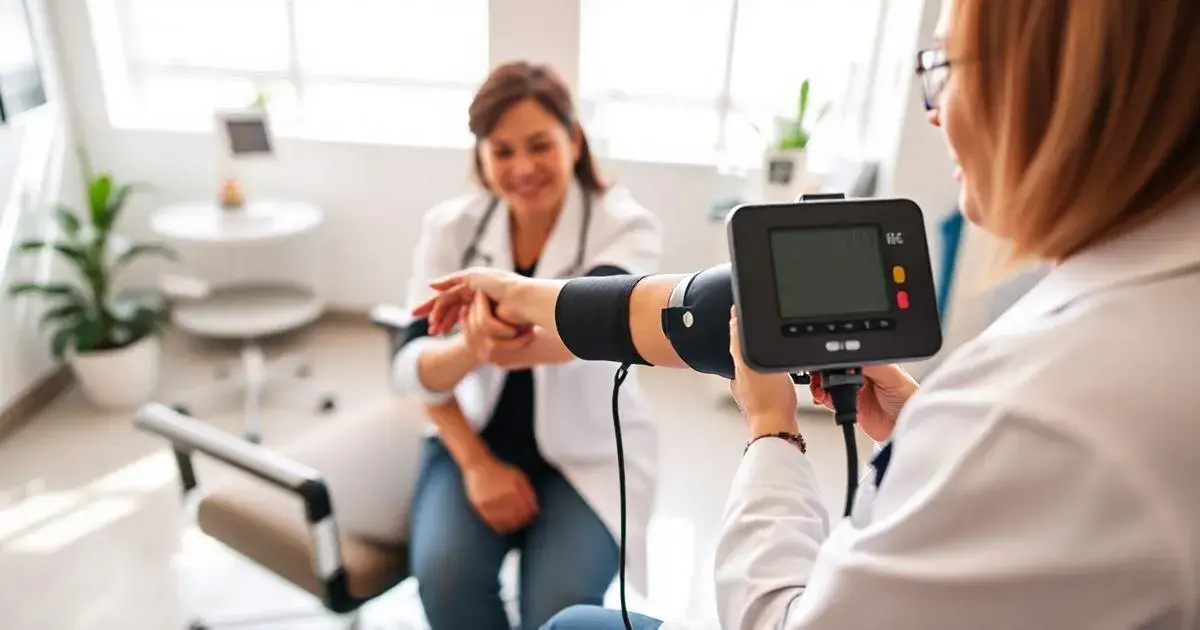How to Measure Blood Pressure Correctly: A Step-by-Step Guide
Are you looking to accurately monitor your blood pressure at home but unsure of the correct method to do so? Proper blood pressure measurement is crucial in managing your health. In today’s fast-paced world, knowing how to measure blood pressure correctly can be empowering for individuals aiming to take control of their well-being.
Recent studies have shown that incorrect blood pressure measurements can lead to misdiagnosis and inappropriate treatments. Therefore, following a step-by-step guide for measuring blood pressure accurately is essential. By understanding the correct techniques, you can ensure that you are getting reliable readings that can aid in maintaining your cardiovascular health.

The Importance of Accurate Blood Pressure Measurement
Accurate blood pressure measurement is crucial for monitoring and managing hypertension, a condition that can lead to serious health problems if left untreated. One way to ensure accuracy is by using a validated blood pressure monitor, such as the Omron Platinum Blood Pressure Monitor. This device has been clinically validated for accuracy and is recommended by healthcare professionals.
To measure your blood pressure accurately, follow these steps:
Step 1: Prepare for measurement
Before taking your blood pressure, sit quietly for at least 5 minutes. Relax your arm and place it on a flat surface, such as a table, at heart level.
Step 2: Use the correct cuff size
Make sure you are using the right size cuff for your arm. A cuff that is too small or too large can result in inaccurate readings. The Omron Platinum Blood Pressure Monitor comes with a ComFit cuff that fits arms from 9 to 17 inches in circumference.
Step 3: Position the cuff properly
Wrap the cuff around your bare upper arm, about an inch above the elbow. The bottom of the cuff should be approximately one inch above the bend of your elbow.
Step 4: Take multiple readings
It is recommended to take at least two or three readings, 1-2 minutes apart, and then average the results. This can help account for variability in blood pressure measurements.
Step 5: Record your readings
Keep track of your blood pressure readings in a journal or using a blood pressure monitoring app like “Blood Pressure Diary” available on the App Store. This can help you and your healthcare provider track trends and adjust your treatment plan if necessary.
Choosing the Right Equipment for Blood Pressure Monitoring
When it comes to monitoring your blood pressure at home, choosing the right equipment is essential for accurate readings. The Withings BPM Connect is a popular choice among consumers for its ease of use and reliability. Here’s how you can select the right equipment:
Step 1: Consider the type of monitor
There are two main types of blood pressure monitors: upper arm monitors and wrist monitors. Upper arm monitors are generally more accurate, so it’s recommended to choose this type for reliable readings.
Step 2: Look for validated monitors
Choose a blood pressure monitor that has been validated for accuracy by reputable organizations like the British Hypertension Society or the Association for the Advancement of Medical Instrumentation (AAMI).
Step 3: Check for additional features
Some blood pressure monitors come with extra features such as smartphone connectivity or irregular heartbeat detection. Consider your specific needs and choose a monitor that offers the features you find most useful.
Step 4: Ensure proper sizing
Make sure the cuff size of the blood pressure monitor fits your arm correctly. Most monitors come with adjustable cuffs, but it’s important to check the sizing guidelines provided by the manufacturer.
Step 5: Read reviews and compare prices
Before making a purchase, read reviews from other users and compare prices from different retailers. Websites like Amazon and Consumer Reports can provide valuable insights into the performance and reliability of blood pressure monitors.
Tips and Tricks for Obtaining Consistent Blood Pressure Readings
Consistency is key when it comes to monitoring your blood pressure. By following these tips and tricks, you can ensure that your readings are accurate and reliable:
Tip 1: Take readings at the same time each day
For the most consistent results, try to take your blood pressure measurements at the same time every day. This can help account for natural fluctuations in blood pressure throughout the day.
Tip 2: Avoid caffeine and exercise before measuring
Caffeine and exercise can temporarily raise your blood pressure, so it’s best to avoid them at least 30 minutes before taking a reading. Sit quietly for a few minutes before measuring to help stabilize your blood pressure.
Tip 3: Stay still during the measurement
Avoid talking or moving while the blood pressure monitor is taking a reading. Sit quietly with your back supported and feet flat on the ground for the most accurate results.
Tip 4: Keep a log of your readings
Tracking your blood pressure readings over time can provide valuable information to your healthcare provider. Use a dedicated app like “Qardio” to log your measurements and easily share them with your doctor.
Tip 5: Follow the manufacturer’s instructions
Each blood pressure monitor may have specific instructions for use, such as positioning the cuff or maintaining the device. Be sure to read and follow the manufacturer’s guidelines for the most accurate readings.

Ensuring Accuracy in Blood Pressure Measurements
Ensuring accuracy in blood pressure measurements is crucial for obtaining reliable data on an individual’s cardiovascular health. One of the key factors in achieving precise results is using a high-quality blood pressure monitor. It is essential to select a device that has been validated for accuracy by regulatory bodies such as the FDA or the European Society of Hypertension.
Another important factor to consider is the proper technique for taking blood pressure measurements. It is recommended to sit quietly for at least five minutes before taking a reading, as movement and stress can affect the results. The individual should be in a comfortable position with their back supported and feet flat on the ground.
When taking the measurement, the cuff should be placed on the upper arm at heart level. It is crucial to position the cuff correctly to ensure accurate results. The individual conducting the measurement should also be trained in the proper technique to avoid any errors that could affect the outcome.
Regular calibration of the blood pressure monitor is also necessary to ensure accurate readings. Calibration helps to maintain the device’s accuracy and reliability over time. It is recommended to calibrate the monitor annually or as per the manufacturer’s instructions.
In conclusion, ensuring accuracy in blood pressure measurements requires the use of a high-quality monitor, proper technique, correct positioning of the cuff, and regular calibration. By following these steps, healthcare professionals can obtain reliable data to assess an individual’s cardiovascular health accurately.
Proper Techniques for Monitoring Blood Pressure Levels
Monitoring blood pressure levels correctly is essential for tracking changes in cardiovascular health and making informed decisions about treatment. One of the key techniques for proper monitoring is consistency in the timing of measurements. It is recommended to take blood pressure readings at the same time each day to ensure accuracy.
Another important technique is to avoid caffeine, tobacco, and exercise for at least 30 minutes before taking a measurement. These factors can temporarily increase blood pressure and affect the results. The individual should also be seated quietly for a few minutes before the reading to allow their heart rate to stabilize.
Proper positioning is crucial for accurate readings. The individual should sit with their back supported and feet flat on the ground. The arm with the cuff should be supported at heart level, and the individual should not talk during the measurement to avoid any interference.
It is also recommended to take multiple readings and calculate the average to get a more accurate representation of the individual’s blood pressure. By monitoring blood pressure levels consistently and using proper techniques, healthcare professionals can track changes effectively and make appropriate recommendations for treatment.
Achieving Reliable Blood Pressure Results
Achieving reliable blood pressure results is essential for accurate diagnosis and management of hypertension. One of the key factors in obtaining reliable readings is proper cuff size. Using a cuff that is too small or too large can lead to inaccurate measurements. It is important to ensure the cuff fits the individual’s arm correctly.
Another factor to consider is the importance of rest before taking a measurement. Stress and physical activity can elevate blood pressure temporarily, leading to inaccurate results. It is recommended to sit quietly for at least five minutes before the reading to ensure a more reliable outcome.
Regularly tracking and documenting blood pressure readings can help identify patterns and changes over time. This data is valuable for healthcare professionals in assessing the effectiveness of treatment and making adjustments as needed. By consistently monitoring blood pressure levels and following proper techniques, individuals can achieve reliable results for better cardiovascular health.
Conclusion
Ensuring accuracy in blood pressure measurements is crucial for assessing an individual’s cardiovascular health reliably. By using a high-quality blood pressure monitor validated by regulatory bodies, such as the FDA or the European Society of Hypertension, precise results can be achieved. Proper technique, including sitting quietly before measurements, positioning the cuff correctly at heart level, and regular calibration of the monitor, is essential for accurate readings.
Monitoring blood pressure levels correctly involves consistency, avoiding factors like caffeine and exercise before measurements, and proper positioning for accurate results. By following these techniques, healthcare professionals can track changes effectively and provide informed recommendations for treatment. Taking multiple readings and calculating the average further enhances the accuracy of blood pressure monitoring.
Achieving reliable blood pressure results requires using the correct cuff size, ensuring rest before measurements, and regularly tracking and documenting readings. This data is invaluable for assessing treatment effectiveness and making necessary adjustments. By consistently monitoring blood pressure levels and following proper techniques, individuals can achieve reliable results, contributing to better cardiovascular health.
